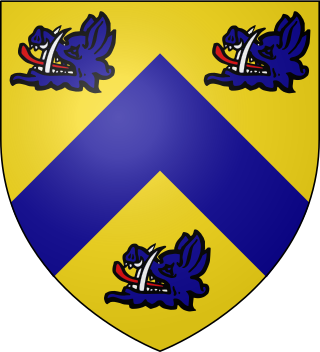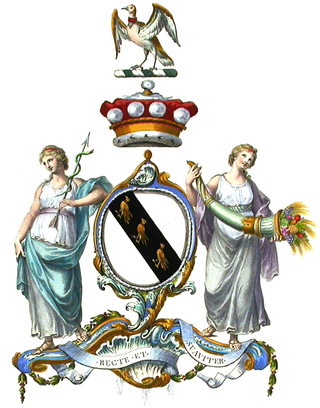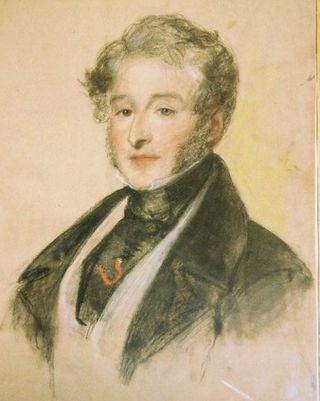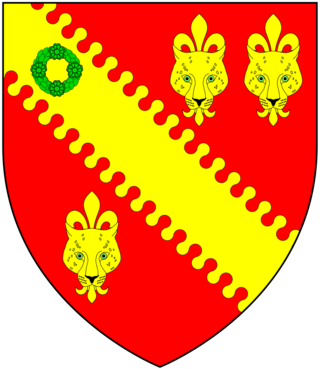
Marquess of Cholmondeley is a title in the Peerage of the United Kingdom. It was created in 1815 for George Cholmondeley, 4th Earl of Cholmondeley.

Earl Ferrers is a title in the Peerage of Great Britain. It was created in 1711 for Robert Shirley, 14th Baron Ferrers of Chartley. The Shirley family descends from George Shirley of Astwell Castle, Northamptonshire. In 1611 he was created a Baronet, of Staunton Harold in the County of Leicester, in the Baronetage of England. He was succeeded by his son Henry, the second Baronet, who married Lady Dorothy Devereux, daughter of Robert Devereux, 2nd Earl of Essex. On the death of her brother Robert Devereux, 3rd Earl of Essex, she became the youngest co-heir to the baronies of Ferrers of Chartley and the barony of Bourchier, which had fallen into abeyance on the death of the third Earl. Shirley was succeeded by his eldest son, the third Baronet. He died unmarried and was succeeded by his younger brother, the fourth Baronet. He was imprisoned in the Tower of London by Oliver Cromwell and died there in 1656. On his death the title passed to his eldest son, the fifth Baronet. He died at an early age and was succeeded at birth by his posthumous son, the sixth Baronet.

Lord Napier, of Merchistoun, is a title in the Peerage of Scotland. It was created in 1627 for Sir Archibald Napier, 1st Baronet. Earlier that year, he already held the Napier Baronetcy, of Merchistoun in the County of Midlothian, created in the Baronetage of Nova Scotia. The titles remained united until 1683, when the Baronetcy became dormant. It was revived in the early 19th century and is now held by another branch of the Napier family. Between 1683 and 1686, the Lords of Napier also held the Nicolson Baronetcy, of Carnock in the County of Stirling, and since 1725 the Scott Baronetcy, of Thirlestane in the County of Selkirk, both baronetcies created in the Baronetage of Nova Scotia. The latter is still held today. Additionally, the tenth Lord was created Baron Ettrick, of Ettrick in the County of Selkirk in the Peerage of the United Kingdom on 16 July 1872.

Lord Rollo, of Duncrub in the County of Perth, is a title in the Peerage of Scotland. It was created on 10 January 1651 for Sir Andrew Rollo, with remainder to his heirs male whatsoever. His great-great-grandson, the fifth Lord, was a Brigadier-General in the Army and fought in North America during the Seven Years' War. He died without surviving male issue and was succeeded by his younger brother, the sixth Lord. His grandson, the eighth Lord, sat in the House of Lords as a Scottish representative peer from 1841 to 1846. His son, the ninth Lord, was a Scottish Representative Peer from 1847 to 1852. His son, the tenth Lord, sat in the House of Lords as a Scottish Representative Peer from 1860 to 1868. On 29 June 1869 he was created Baron Dunning, of Dunning and Pitcairns in the County of Perth, in the Peerage of the United Kingdom, with remainder to the heirs male of his body. This title gave the Lords an automatic seat in the House of Lords until 1999. As of 2017 the titles are held by the tenth Lord's great-great-grandson, the fourteenth Lord, who succeeded his father in 1997. He is the hereditary Clan Chief of Clan Rollo.
Viscount Colville of Culross, in the County of Perth, is a title in the Peerage of the United Kingdom. It was created on 15 July 1902 for the politician and courtier, Charles Colville, 10th Lord Colville of Culross. He had already been created Baron Colville of Culross, in the County of Perth, in 1885, also in the Peerage of the United Kingdom. As of 2018, the titles are held by his great-great-grandson, the fifth Viscount, who succeeded his father in 2010. The fourth Viscount was a judge and politician. Lord Colville of Culross was one of the ninety elected hereditary peers that remained in the House of Lords after the passing of the House of Lords Act 1999, and sat as a crossbencher.

Viscount Scarsdale, of Scarsdale in Derbyshire, is a title in the Peerage of the United Kingdom. It was created in 1911 for the prominent Conservative politician and former Viceroy of India George Curzon, 1st Baron Curzon of Kedleston, who was created Earl Curzon of Kedleston at the same time and was later made Marquess Curzon of Kedleston.

Baron Rodney, of Rodney Stoke in the County of Somerset, is a title in the Peerage of Great Britain. It was created in 1782 for the naval commander Sir George Brydges Rodney, 1st Baronet. He had previously been created a Baronet, of Alresford in the County of Southampton, in the Baronetage of Great Britain on 22 January 1764. His son, the second Baron, represented Northampton in Parliament. He was succeeded by his eldest son, the third Baron. He served as Lord Lieutenant of Radnorshire. His younger brother, the fourth Baron, assumed by Royal licence the additional surname of Harley in 1804. On his death the titles passed to his younger brother, the fifth Baron. He was Rector of Elmley in Kent. He was succeeded by his nephew, the sixth Baron. He was the son of Captain the Hon. Robert Rodney, fourth son of the second Baron. The sixth Baron's great-grandson, the ninth Baron, was an active member of the House of Lords and served as a Delegate to the Council of Europe and the Western European Union. As of 2011 the titles are held by the latter's grandson, the eleventh Baron, who succeeded in 2011.

Baron Dinevor, of Dinevor in the County of Carmarthen, is a title in the Peerage of Great Britain. It was created on 17 October 1780 for William Talbot, 1st Earl Talbot, with remainder to his daughter, Lady Cecil, wife of George Rice, a member of a prominent Welsh family. On Lord Talbot's death the earldom became extinct because he left no sons to succeed to it, while the barony of Talbot also held by him was inherited by his nephew. The barony of Dynevor passed according to the special remainder to his daughter, the second holder of the title. In 1787 Lady Dynevor assumed by Royal licence the surname of de Cardonnel in lieu of Rice.

Baron Newborough is a title that has been created twice in the Peerage of Ireland; both titles are extant. The first creation came in 1716 in favour of George Cholmondeley, later 2nd Earl of Cholmondeley. See Marquess of Cholmondeley for further history of this creation.

Baron Glentoran, of Ballyalloly in the County of Down, is a title in the Peerage of the United Kingdom. It was created on 8 July 1939 for the Unionist politician Herbert Dixon. In 1950 he also succeeded his elder brother as third Baronet, of Ballymenock. His son, the second Baron, was also a politician and served as the last Speaker of the Senate of Northern Ireland. As of 2017 the titles are held by the latter's son, the third Baron, who succeeded in 1995. He is a former Olympic bobsleigh gold medallist as well as a soldier, businessman and politician. Lord Glentoran was one of the ninety elected hereditary peers who remain in the House of Lords after the passing of the House of Lords Act 1999, and sat on the Conservative benches until his June 2018 retirement under the House of Lords Reform Act 2014.
Baron de Mauley, of Canford in the County of Dorset, is a title in the Peerage of the United Kingdom. It was created on 10 July 1838 for the Whig politician the Hon. William Ponsonby, who had earlier represented Poole, Knaresborough and Dorset in the House of Commons. He was the third son of the 3rd Earl of Bessborough, an Anglo-Irish peer, and his wife Lady Henrietta Spencer, daughter of the 1st Earl Spencer. He married Lady Barbara Ashley-Cooper, the daughter of Anthony Ashley-Cooper, 5th Earl of Shaftesbury. She was one of the co-heirs to the ancient barony by writ of Mauley, which superseded the feudal barony the caput of which was at Mulgrave Castle, Yorkshire, which barony by writ had become extinct in 1415.

Baron Ampthill, of Ampthill in the County of Bedfordshire, is a title in the Peerage of the United Kingdom. It was created on 11 March 1881 for the diplomat Lord Odo Russell. He was the third son of Major-General Lord George Russell, second son of John Russell, 6th Duke of Bedford.
Baron Addington, of Addington in the County of Buckingham, is a title in the Peerage of the United Kingdom. It was created on 22 July 1887 for the businessman and Conservative Member of Parliament, John Hubbard. He was head of the firm of John Hubbard & Co and also sat as a Member of Parliament for Buckingham and the City of London. His eldest son, the second Baron, was a partner in the family firm and represented Buckingham in the House of Commons as a Conservative. He was succeeded by his eldest son, the third Baron. He was three times Mayor of Buckingham. On the death of his younger brother, the fourth Baron, the line of the eldest son of the first Baron failed. The title passed to their first cousin once removed, the fifth Baron. He was the grandson of Cecil John Hubbard, third son of the first Baron. As of 2018, the title is held by his eldest son, the sixth Baron. He is one of the ninety elected hereditary peers that remain in the House of Lords after the passing of the House of Lords Act of 1999. Lord Addington sits on the Liberal Democrat benches.

Baron Morris, of St John's in the Dominion of Newfoundland and of the City of Waterford, is a hereditary barony in the Peerage of the United Kingdom which was created on 15 January 1918 for the lawyer and politician Sir Edward Morris upon his retirement as Prime Minister of Newfoundland.
Baron Bridges, of Headley in the County of Surrey and of Saint Nicholas at Wade in the County of Kent, is a title in the Peerage of the United Kingdom. It was created on 4 February 1957 for the prominent civil servant Sir Edward Bridges. He was Cabinet Secretary from 1938 to 1946. He was succeeded by his son, the second Baron, in 1969. He notably served as British Ambassador to Italy from 1983 to 1987. Lord Bridges was one of the ninety-two elected hereditary peers that remained in the House of Lords after the passing of the House of Lords Act 1999, before his removal for non-attendance in 2016. As of 2017 the title is held by his son, the third Baron, who succeeded to the title in that year. He was the solicitor to, among others, Queen Elizabeth II and other members of the royal family.

Baron Tennyson, of Aldworth in the County of Sussex and of Freshwater in the Isle of Wight, is a title in the Peerage of the United Kingdom. It was created in 1884 for the poet Alfred Tennyson. His son, the second Baron, served as Governor-General of Australia, and his grandson, the third Baron, as a captain for the English cricket team. On the death in 2006 of the latter's younger son, the fifth Baron, the line of the eldest son of the first Baron failed. The title was inherited by the late Baron's second cousin once removed, the sixth and present holder of the peerage. He is the great-grandson of Hon. Lionel Tennyson, second son of the first Baron.
Baron Crawshaw, of Crawshaw in the County Palatine of Lancaster and of Whatton in the County of Leicester is a title in the Peerage of the United Kingdom. It was created on 25 August 1892 for Sir Thomas Brooks, 1st Baronet. He notably served as High Sheriff of Lancashire in 1884. Brooks had already been created a baronet in the Baronetage of the United Kingdom, of Crawshaw Hall and Whatton House, on 9 February 1891. As of 2013 the titles are held by his great-grandson, the fifth Baron, who succeeded his elder brother in 1997.

Baron Rothschild, of Tring in the County of Hertfordshire, is a title in the Peerage of the United Kingdom. It was created in 1885 for Sir Nathan Rothschild, 2nd Baronet, a member of the Rothschild banking family. He was the first Jewish member of the House of Lords not to have previously converted to Christianity. The current holder of the title is Nathaniel Rothschild, 5th Baron Rothschild, who inherited the barony in February 2024.

Baron Rea, of Eskdale in the County of Cumberland, is a title in the Peerage of the United Kingdom. It was created in 1937 for the businessman and Liberal politician Sir Walter Rea, 1st Baronet, who had earlier represented Scarborough, Bradford North and Dewsbury in the House of Commons. He had already been created a Baronet, of Eskdale in the County of Cumberland, in 1935. He was succeeded by his eldest son, the second Baron. During the Second World War he served as personal staff officer to Brigadier Colin Gubbins, the Head of SOE, a key British intelligence and guerrilla operations agency. Lord Rea served as Leader of the Liberal Party in the House of Lords from 1955 to 1967. His daughter, the Right Hon. Ann Felicity Rea, married SOE veteran Malcolm Munthe in 1945. His nephew, the third Baron, who succeeded in 1981, was a physician. He was one of the ninety elected hereditary peers elected to remain in the House of Lords after the passing of the House of Lords Act 1999, and sat on the Labour benches. As of 2020 the titles are held by his son, the fourth Baron, who succeeded his father in that year.

Earl of Arran is a title in the Peerage of Ireland. It is not to be confused with the title Earl of Arran in the Peerage of Scotland. The two titles refer to different places: the Aran Islands in Ireland, and the Isle of Arran in Scotland. The Irish earldom is held by the Gore family. The Scottish earldom is a separate title, held as a subsidiary title of the Duke of Hamilton.

















